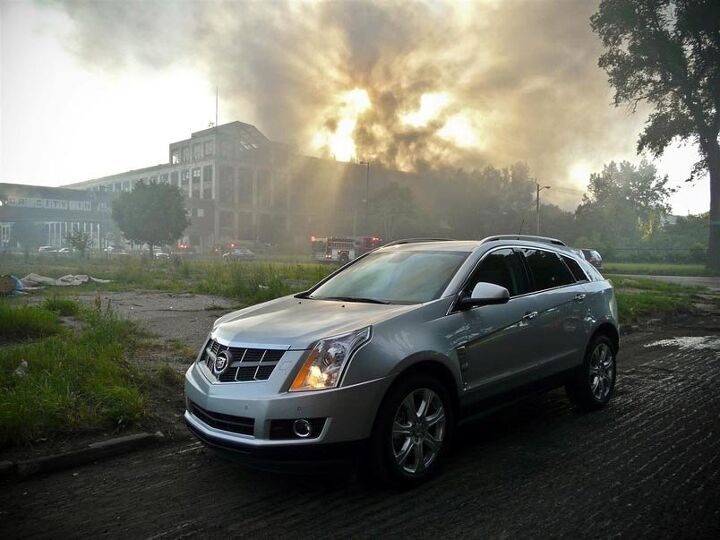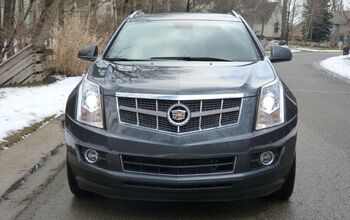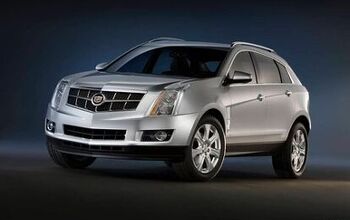Review: 2010 Cadillac SRX V6

Since day one, the Cadillac SRX was a desperate underdog looking to dethrone the Lexus RX: Middle America’s CUV of choice. But the SRX was a muscular macho machine and the Lexus is an overstuffed Camry Wagon. Now, with a more mundane blueprint, Cadillac believes their latest SRX utility is “the new standard for luxury crossovers.” Plus, as the promotional material claims, it’s also the Cadillac of Crossovers. Whoa dude: what standard are they holding themselves to, and does anyone still believe Cadillac is the ultimate word in luxury?
Starting from the greenwashed Provoq concept of 2008, the SRX is the nicest interpretation of the brand’s jarring Art and Science aesthetic. The bumper’s pronounced wedge flows logically into Cadillac’s corporate grille and stacked headlight clusters. The fastback roofline drops behind the B-pillar, yet passenger ingress/egress isn’t affected. And while the large D-pillar and tailfin-esque rear lighting pods are undoubtedly Cadillac, something looks wrong.
GM Theta Platform uber alles: the wrong-wheel drive architectural hard points mean last year’s muscle makes way for clumsy and un-American. The side profile’s swage line works, until it draws you to the solid ventiports that don’t bother with a misleading grille. Even worse, it sports a GM Mark of Excellence logo that won’t come off with a screwdriver and WD-40. The tall front fenders are pure import-wannabe, with fake greenhouse extensions giving the illusion of a vehicle with a more unique blueprint. At least the optional 20-inch, six-lug hoops provide a tough stance, even if the dual exhausts look better than they sound.
But go inside, getting back to Cadillac’s “new standard” for the CUV-genre. The center stack is an upscale affair, even with DNA shared with lesser GM products. Too bad adjusting the long toothed vent registers creates more flex than the sails on a vintage racing boat in a typhoon. The door’s rich wood paneling is denied access to the dour dashboard and overwrought, plasticized console. Yet the SRX’s front buckets truly disappoint: the driver’s seat bottom has respectable bolstering and an M-series worthy pull out thigh support, but the passenger gets a hunk of foam with the consistency of a half-melted marshmallow. Then I clocked the badge on the tiller: this is supposed to be a Caddy?
But the SRX occasionally raises the bar: witness the multi-information panel in the speedometer. The HDMI-worthy resolution screen, clear interface and beautiful graphics at start-up are a clear winner for any car, at any price. The jeweled edges to the cluster double as redundant turn signal indicators: the green arrows of conventional wisdom meet their match, even if Cadillac retained them for the un-intuitive.
While the 3D graphics on the (optional) navigation system are ergo-friendly and work sans i-Drive interface, the BOSE beat box lacks the imaging qualities of the Lincoln MKX’s bullhorn-esque rear THX tweeters and the awesome thump of Lexus’ Mark Levinson-fettled cabins.
Not all is lost elsewhere. The SRX shines on the open road, though safe passage in a parking lot is no small feat with forward leaning, thick A-pillars blocking views of curbs, strollers and
subcompacts. Smooth roads exploit negligible body roll at sane speeds. The whole experience is Teutonic, with less tendency to understeer than a car, much less the roly-poly Lexus RX. But the hydraulic based steering gear was a surprise: excellent on-center feel and brilliant communication in fast sweepers. So Cadillac made quite the corner carver. You know, for a CUV.
And the excuses continue underhood, as the 3.0L direct-injected V6 makes adequate thrust, provided stoplight drags with the RX350 aren’t in your future. On the plus side, torque steer (with 223lb-ft) on the 4300lb Caddy is a non-issue. While a smaller displacement, turbocharged and all-wheel drive alternative is en route later this year, Cadillac is going about this incorrectly: why go smaller and busier when a V8 is the logical choice?
Oh, that’s right: global designs, cost savings and all that jive. So the SRX makes due with everyone else’s engineering, rearing its ugly head in ride comfort. While road noise is Lexian at speeds, the big wheels, firm dampeners and clumsy CUV stance make for a crude ride on pothole-soaked urban roads. Forget about wafting like a real Caddy, the SRX has nothing on the RX350. And this grip/comfort trade off is reverse Viagra for the average CUV buyer.
Plus, with nearly a 20 cu-ft deficit in cargo space, the Lexus RX’s perennial success remains untouchable. Cadillac is a brand in desperation: from the standard leatherette interior to the gutless engine, the SRX looks for signs of life via blueprints from the best (worst?) intentions of others. So GM’s top brand is doomed to live in a Lexus-shaped shadow until they grow a pair, investing in a unique platform. And sweat every last detail in the process.

More by Sajeev Mehta
Latest Car Reviews
Read moreLatest Product Reviews
Read moreRecent Comments
- ToolGuy First picture: I realize that opinions vary on the height of modern trucks, but that entry door on the building is 80 inches tall and hits just below the headlights. Does anyone really believe this is reasonable?Second picture: I do not believe that is a good parking spot to be able to access the bed storage. More specifically, how do you plan to unload topsoil with the truck parked like that? Maybe you kids are taller than me.
- ToolGuy The other day I attempted to check the engine oil in one of my old embarrassing vehicles and I guess the red shop towel I used wasn't genuine Snap-on (lots of counterfeits floating around) plus my driveway isn't completely level and long story short, the engine seized 3 minutes later.No more used cars for me, and nothing but dealer service from here on in (the journalists were right).
- Doughboy Wow, Merc knocks it out of the park with their naming convention… again. /s
- Doughboy I’ve seen car bras before, but never car beards. ZZ Top would be proud.
- Bkojote Allright, actual person who knows trucks here, the article gets it a bit wrong.First off, the Maverick is not at all comparable to a Tacoma just because they're both Hybrids. Or lemme be blunt, the butch-est non-hybrid Maverick Tremor is suitable for 2/10 difficulty trails, a Trailhunter is for about 5/10 or maybe 6/10, just about the upper end of any stock vehicle you're buying from the factory. Aside from a Sasquatch Bronco or Rubicon Jeep Wrangler you're looking at something you're towing back if you want more capability (or perhaps something you /wish/ you were towing back.)Now, where the real world difference should play out is on the trail, where a lot of low speed crawling usually saps efficiency, especially when loaded to the gills. Real world MPG from a 4Runner is about 12-13mpg, So if this loaded-with-overlander-catalog Trailhunter is still pulling in the 20's - or even 18-19, that's a massive improvement.




































Comments
Join the conversation
Until several days ago, I wouldn’t have even looked sideways at a crossover vehicle, let alone consider buying one. But a sudden and looming requirement to drive two or three regular 170 miles round trips per week for the foreseeable future puts me in the market for a third car. With a 4.3 years old Cadillac XLR-V and a fresh 2010 CTS-V in the garage, it seems sensible to consider something a little homeowner-practical that’s neither a sedan nor GT. If I let my heart drive the decision, I’d just wait for July and pick up an early CTS Coupe V (and lord knows I still could), but do I really need another high power car? Not really. So how about something with more utility but still crisp? I once had a magnificent F150 Harley crew cab. It was exceedingly practical and entertaining in its truckiness, except when it wasn’t. I had an F150 SVT Lightning that was even more entertaining but too Spartan and cramped for this mission. So no retracing steps. A CTS Wagon briefly tempts but I never liked the Lincoln Log proportions of wagons, and the Brits calling them “estate cars” doesn’t change the feeling of driving a pipe. The mid-size and compact crew cab pickups lack presence and their interiors (including seats) suck. An Escalade looked like a possibility. Hell, I’d even have popped for the 2Mode Hybrid, but the whole profile just isn’t me. So for the first time, the existence of the SRX caught my eye in the periphery. Head for the web. I’ve had an all-but-perfect experience owning Cadillacs since early 2006. My XLR-V has given me no trouble worth mentioning, and our 2006 CTS-V had only one unscheduled service – the TSB on the differential pinion seal. It was obvious that car should be succeeded by the 2nd generation CTS-V so that transaction was easily done. Inclined to continue with Cadillac, the SRX has my attention, but I paused to go drive the principle players in the category for context. Oy. The Lexus RX really is a wallowing pig and the interior is slipping downmarket fast. Oh, it’s perfectly crafted to make a strong 15 seconds impression, but it doesn’t stand up to 15 minutes of scrutiny let alone 15 months. Or 60. The Germans have somehow managed to get a common training on how to make these unibody utes feel ponderous even when they are dynamically competent. They generally add useless mass and you can feel the necessary hardware and computational engineering constantly fighting it, even when the vehicle is going where you intended. BMW, Audi, Mercedes and Porsche all have their specific thumbprint on the genre, but they are more the same than different, and not in a good way. BMW, Porsche and Audi add the insult of particularly inept interior space utilization. So on balance, no. I’m not prepared to live with any of them. The Ford and GM alternatives to the SRX are either bigger than I care to have hanging out behind me, or too downmarket for the mission. Infiniti? Not good enough to justify sending a briefcase of money out of the country. Lincoln? Well....presently just too strange. So, after reading all the squawking about the SRX 3.0L drivetrain’s torque anemia and indecisive transmission, I drove one. OK, I see the point but the software governance of the transmission has improved things, and…well…there’s always some way to hot-rod the factory engine bay. And that’s when I stumbled on the existence of the 2.8L SRX Turbo. Hmmm…torque band mesa-flat from 2000rpm to roughly redline. Aisin shiftable six-ratio? Good match. I’m here to drive *that* one. First, the static requirements. 1/ Beautiful interior, and in its embrace in real-world 3D it isn’t nearly as polygon-fussy as it appears in flat photographs. 2/ It passes my essential test for anything with four doors: I’m 6’3” so can I “sit behind myself?” Yes. And with the adjustable seatback rack on the back seat, I can do it comfortably. 3/ Ergonomics? Brand familiar. Everything is where it should be. 4/ Adjustable pedals? Perfect. My wife is a foot shorter than me. 5/ Excellent interior space utilization relative to exterior dimensions. 6/ Sharply-styled vehicle with presence; more than any crossover can expect to have. 6/ High-visibility greenhouse with a big-screen view through the rear camera to help. 7/ Easy to read and use navigation system. I read some criticism of the Bose sound system. Now, I’m no fan of Bose, but frankly all these high-end car sound systems suck. It doesn’t matter whether the logo says Levinson, B&O, B&W, Harman….whatever. None of them sound remotely realistic nor competitive with quality home audio. So drop the pretense. This sound system is just one of many ways automakers collaborate with audio brands to dream up a completely faux fidelity in the acoustically ridiculous audiospace of an automobile. If you think a car audio system is a selling point, you’re deaf, innocently unaware or just don’t care. And no, digital signal processing doesn’t fix it, nor make your desiccated-digits iPod sound good. Underway, all the ambivalence I had about driving a crossover vanished. Thanks to a truly-rigid structure and GM’s sensationally simple but effective computer-controlled magnetorheological damping, the SRX Turbo corners flat, is stable at speed, dynamically predictable and as an added engineering bonus, it’s blessed with precision steering with incisive feedback that shames most sedans. The Aisin shifts crisply, especially in performance mode, and do-it-yourself-shifts follow your inputs real-time and hold gear to redline. The 2.8L with the spinner gets the 2+ tons moving quickly, and midrange speed changes put reserve steam at your disposal. I read reviews that praised this engine for complete lack of turbo lag, and a few others complaining the engine feels dated because of turbo lag. Turbo lag is for practical purposes non-existent. My guess is the reviewer who complained tanked up with regular gas. The Turbo SRX is estimated to have a 0 – 60 time of 7.5 seconds. It sure feels quicker, and my experience on SoCal onramps strongly suggests it is. Or maybe I’m just good at whipping it. But it doesn’t complain. Keep in mind, my daily drivers are 4 second cars, +/-. If this car were truly slow, I’d feel it. As it is, the Turbo 6 has about the same power as a 1996 SVT Cobra I owned for 10 years. Add the crossover’s extra mass, and motive performance seems fine to me. If there’s anything in the category quicker at the price it’s not enough of a factor to discount the car's handling. The Turbo SRX leads the field in that respect. Dynamically, this SRX completely conceals its tall car reality. It may not be light, but it feels lighter on its feet than anything else in the category. The 2010 SRX Turbo drives smaller than its size, has convincing power and dynamics with an admirable CTS-quality interior. For me, the seats are excellent and the Turbo puts leather everywhere you care to have it. My experience with 2006 and later Cadillac interiors suggests interior materials will hold up. My XLR-V interior still looks and feels new over four years later, and our lease turn-in 2006 CTS-V showed no apparent wear despite being a lesser execution than current Cadillac standards. At $55,000 fully loaded (Turbo Premium) I can’t fault it in the context of today’s warped market. More power (or less mass) is always appreciated but in actual driving, for its type the vehicle weighs what it should and moves crisply. I’m days from a decision but if I buy in the category, this is it. Phil
Ugly plastic coated hearse for Pygmies.